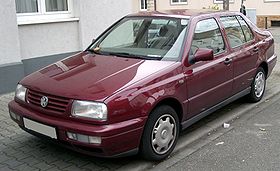| Volkswagen Vento (A3, Typ 1H) | |
|---|---|
 | |
| Overview | |
| Also called | Volkswagen Jetta |
| Production | January 1992 – February 1999[1] |
| Assembly | |
| Designer | Herbert Schäfer |
| Body and chassis | |
| Body style | 4-door notchback sedan / saloon |
| Layout | Front-engine, front-wheel-drive/four-wheel-drive |
| Platform | Volkswagen Group A3 platform |
| Related | Volkswagen Golf Mk3 |
| Powertrain | |
| Engine | 1.6 L I4 (petrol) 1.8 L I4 (petrol) 2.0 L I4 (petrol) 2.8 L VR6 (petrol) 1.9 L I4 D (diesel) 1.9 L I4 TD (diesel) 1.9 L I4 SDI (diesel) 1.9 L I4 TDI (diesel) |
| Transmission | 5-speed manual 4-speed automatic |
| Dimensions | |
| Wheelbase | 2,470 mm (97.2 in) |
| Length | 4,400 mm (173.2 in) |
| Width | 1,690 mm (66.5 in) |
| Height | 1,430 mm (56.3 in) |
| Chronology | |
| Predecessor | Volkswagen Jetta (A2) |
| Successor | Volkswagen Bora |
The Volkswagen Vento is a small family car, the third generation of the Volkswagen Jetta and the successor to the Volkswagen Jetta (A2). For the third generation, the Jetta name was discontinued, and it was officially renamed the Volkswagen Vento in European countries, following the precedent of naming cars after winds, debuted in 1992. The Jetta 3 debuted in North America in 1993 after production delays and quality problems at the Volkswagen plant in Puebla, Mexico.[2] The name "Vento" means "wind" in both Portuguese and Italian. It went on sale in most of Europe in the first quarter of the year, though it did not arrive on the British market until September 1992.
Because of the success of the second generation in North America, Volkswagen decided to keep the Jetta nameplate. However, in Europe the car was given its new name to appeal to a younger market.[3]
Styling was penned by a design team led by Herbert Schäfer, and again the car became more aerodynamic than the previous generation. Although visually similar to the Mark 2, there were many refinements underneath. The two-door model was dropped, aerodynamics were improved, with the car now having a drag coefficient of 0.32.[4] This included a new structure which now met worldwide crash standards.[5] Suspensions were an evolutionary rather than revolutionary refinement of the setup on previous editions, and mainly consisted of a wider track, and even maintaining backwards compatibility with older models. In addition, the car became more environmentally friendly with the use of recycled plastics, CFC-free air conditioning systems, and paint that did not contain heavy metals.[6]
This generation of the car is widely credited for keeping Volkswagen from pulling out of the North American market.[2][7] At the time of its introduction in 1993, Volkswagen of America's sales hit a low not seen since the 1950s. The division sold only 43,902 cars in that year. Sales began slowly due to the aforementioned issues at the Puebla plant.[8] However, sales rebounded dramatically in the following years, mostly based on the strength of the Jetta, which continued to be the best-selling Volkswagen in the USA.[9]
- ^ a b c d ETKA[clarification needed]
- ^ a b Robson, p. 208
- ^ Plumb, Steven E. (March 1992). "VW Jetta replacement coming next fall". Ward's Auto World.
- ^ Visnic, Bill (December 1993). "VW's new Golf, Jetta try for a comeback". Ward's Auto World.
- ^ Robson, p. 202
- ^ Volkswagen Jetta. Auburn Hills, Michigan, USA: Volkswagen of America. 1993. p. 17. Form No. W63 163 6081.
- ^ Jedlicka, Dan (5 March 1994). "Golf and Jetta Drive Revival in VW Sales". Chicago Sun - Times. p. 18.
- ^ "Can Herbie ride again?". The Economist. 23 April 1994. p. 66.
- ^ Robson, p. 210